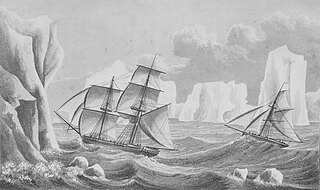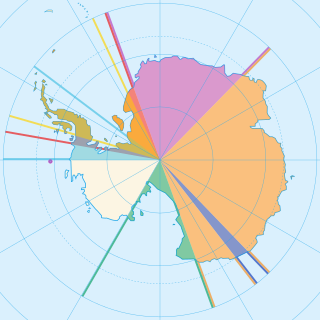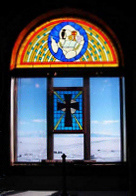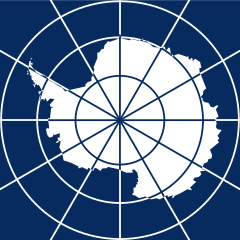
The Antarctic Treaty and related agreements, collectively known as the Antarctic Treaty System (ATS), regulate international relations with respect to Antarctica, Earth's only continent without a native human population. It was the first arms control agreement established during the Cold War, designating the continent as a scientific preserve, establishing freedom of scientific investigation, and banning military activity; for the purposes of the treaty system, Antarctica is defined as all the land and ice shelves south of 60°S latitude. Since September 2004, the Antarctic Treaty Secretariat, which implements the treaty system, is headquartered in Buenos Aires, Argentina.

A holiday is a day or other period of time set aside for festivals or recreation. Public holidays are set by public authorities and vary by state or region. Religious holidays are set by religious organisations for their members and are often also observed as public holidays in religious majority countries. Some religious holidays, such as Christmas, have become secularised by part or all of those who observe them. In addition to secularisation, many holidays have become commercialised due to the growth of industry.

The history of Antarctica emerges from early Western theories of a vast continent, known as Terra Australis, believed to exist in the far south of the globe. The term Antarctic, referring to the opposite of the Arctic Circle, was coined by Marinus of Tyre in the 2nd century AD.

The United States Antarctic Program is an organization of the United States government which has a presence in the Antarctica continent. Founded in 1959, the USAP manages all U.S. scientific research and related logistics in Antarctica as well as aboard ships in the Southern Ocean.
A flag of Antarctica is a flag or flag design that represents the continent of Antarctica. As a condominium with no single governing body, it does not have an official flag of its own. However, several designs have been created for the purpose of representing the continent.

Colonization of Antarctica is the establishing and maintaining of control over Antarctic land for exploitation and possibly settlement.

Multiple governments have set up permanent research stations in Antarctica and these bases are widely distributed. Unlike the drifting ice stations set up in the Arctic, the current research stations of the Antarctic are constructed either on rocks or on ice that are fixed in place.

The Law-Racoviță-Negoiță Station, known only as the Law-Racoviță Station until 2011, is the first Romanian station for research and exploration in Antarctica, named after the Romanian explorer Emil Racoviță and inaugurated on January 13, 2006 at the location of a station constructed in 1986 by Australia and donated to Romania. The station may be found in Princess Elizabeth Land, in the Larsemann Hills, 2 kilometres (1.2 mi) away from China's Antarctic Zhongshan Station.
Global commons is a term typically used to describe international, supranational, and global resource domains in which common-pool resources are found. Global commons include the earth's shared natural resources, such as the high oceans, the atmosphere and outer space and the Antarctic in particular. Cyberspace may also meet the definition of a global commons.

Religion in Antarctica is largely dominated by Christianity, with churches being the only religious buildings on the continent. Although used regularly for Christian worship, the Chapel of the Snows has also been used for Buddhist and Baháʼí Faith ceremonies. Some of the early religious buildings are now protected as important historical monuments.

Seven sovereign states – Argentina, Australia, Chile, France, New Zealand, Norway, and the United Kingdom – have made eight territorial claims in Antarctica. These countries have tended to place their Antarctic scientific observation and study facilities within their respective claimed territories; however, a number of such facilities are located outside of the area claimed by their respective countries of operation, and countries without claims such as China, India, Italy, Japan, Pakistan, Russia, South Africa (SANAE), Poland, and the United States have constructed research facilities within the areas claimed by other countries. There are overlaps among the territories claimed by Argentina, Chile, and the United Kingdom.

Antarctica contains research stations and field camps that are staffed seasonally or year-round, and former whaling settlements. Approximately 12 nations, all signatory to the Antarctic Treaty, send personnel to perform seasonal (summer) or year-round research on the continent and in its surrounding oceans. There are also two official civilian settlements: Villa Las Estrellas in Base Presidente Eduardo Frei Montalva operated by Chile, and Fortín Sargento Cabral in Esperanza Base operated by Argentina.

Antarctica is Earth's southernmost and least-populated continent. Situated almost entirely south of the Antarctic Circle and surrounded by the Southern Ocean, it contains the geographic South Pole. Antarctica is the fifth-largest continent, being about 40% larger than Europe, and has an area of 14,200,000 km2 (5,500,000 sq mi). Most of Antarctica is covered by the Antarctic ice sheet, with an average thickness of 1.9 km (1.2 mi).

The South Pole, also known as the Geographic South Pole or Terrestrial South Pole, is the southernmost point on Earth and lies antipodally on the opposite side of Earth from the North Pole, at a distance of 20,004 km in all directions. It is one of the two points where Earth's axis of rotation intersects its surface.
A national Antarctic program is any government operated or supported program which is mandated with managing the support of scientific research and contributing to the governance and protection of the Antarctic environment on behalf of its nation and in the spirit of the Antarctic Treaty. The Antarctic Treaty, the international agreement that regulates Antarctic activity, has been signed by 54 countries. Of those, 38 have national Antarctic programs. 33 of these programs have a permanent presence in Antarctica and are members of Council of Managers of National Antarctic Programs (COMNAP). Four countries have no permanent presence in Antarctica, but have programs that are observers to COMNAP. Only one country, Pakistan, maintains a national Antarctic program with no affiliation to COMNAP.

There may have been women in Antarctica, exploring the regions around Antarctica for many centuries. The most celebrated "first" for women was in 1935 when Caroline Mikkelsen became the first woman to set foot on one of Antarctica's islands. Early male explorers, such as Richard Byrd, named areas of Antarctica after wives and female heads of state. As Antarctica moved from a place of exploration and conquest to a scientific frontier, women worked to be included in the sciences. The first countries to have female scientists working in Antarctica were the Soviet Union, South Africa and Argentina.
While crime in Antarctica is relatively rare, isolation and boredom affect certain people there negatively and may lead to crime. Alcoholism is a known problem on the continent and has led to fights and indecent exposure. Other types of crime that have occurred in Antarctica include illicit drug use, torturing and killing wildlife, racing motorbikes through environmentally sensitive areas, assault with a deadly weapon, attempted murder and arson. Sexual harassment also has been reported.

Midwinter Day, or Midwinter, is an annual celebration held across Antarctica on the day of the southern winter solstice. It is the continent's primary cultural holiday and, along with Antarctica Day, is one of two principal Antarctic holidays. It is a celebration for personnel overwintering at Antarctic research stations, although some people off the continent observe it as well.

The Antarctic gateway cities are five cities on the rim of the Southern Ocean through which nearly all cargo and personnel bound for Antarctica pass. From west to east, they are Punta Arenas, Chile; Ushuaia, Argentina; Cape Town, South Africa; Hobart, Australia; and Christchurch, New Zealand. As Antarctica is a low-resource environment with no major transportation infrastructure of its own, gateway cities are a necessary part of all Antarctic activities.














